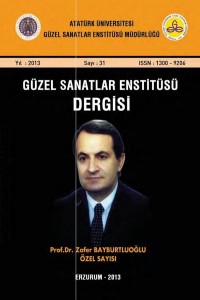Abstract
Da ğçatı Village mosque is one of the mosques of the Ottoman period that has the traditional features. It was built in 1806 at the beginning of XIX. century. It is one of the examples in the country of the traditional wooden architecture. The ceiling of the mosque that has a square planned wooden ceiling rests on the walls on all sides. The mosque has a great importance due to the features of the hand-drown ornament at the indoor. The flowers and branches, “C” and “S” shaped ornaments, symbols and writings form the main theme of the ornament. The mosque’s architect and the master of ornament have not been known. The interior and exterior architecture of the mosque, its decoration and its material have regional characteristics.
References
- Arık, R.(1988). Batılıla şma Dönemi Anadolu Tasvir Sanatı, Ankara.
- Bozer, R. (1987). “Kula Emre Köyünde Resimli Bir Cami”, Türkiyemiz, S.53, 15-22.
- Ça ğlıtütüncügil, E. (2013). “Türk Süsleme Sanatında Nar: “Form, Köken ve İkonografik Anlamı” Türklük Bilimi Araştırmaları, XXXIII, 61-92. Çal, H.(1993). “Tokat Zile Ye şilce Köyü Şeyh Eylük Türbesi” Selçuk Üniversitesi Selçuklu Ara ştırmaları Merkezi Prof. Dr. Yılmaz Önge Arma ğanı, Konya, 293-306.
- Denkta ş, M. (2001). “Kayseri- Develi Şıhlı Kasabası Yusufağa Cami”, Prof. Dr. Zafer Bayburtluo ğlu’na Armağan, Sanat Yazıları, Kayseri, 20120
- Denkta ş, M. (2004). “Pınarbaşı Uzunyayla’daki Ahşap Direkli Camiler”, E. Ü. Sosyal Bilimler Enstitüsü Dergisi, S.16, Kayseri, 53-89.
- Duran, R.(1992). “Seki-Tekke Camii ve Tekke Sanatı ile İlgisi Üzerine” Dokuz Eylül Üniversitesi, İlahiyat Fakültesi Dergisi, VII, İzmir, 3233
- Karpuz, H.(1990). “Trabzon’un Çaykara İlçesi Köylerinde Bulunan Bazı Camiler” Vakıflar Dergisi, Sayı, XXI, İstanbul, 281-299.
- Kö şklü, Z.(1993). I. Abdülhamid Dönemi (1774–1789) Osmanlı Dini Mimarisi, Atatürk Üniversitesi Sosyal Bilimler Enstitüsü Arkeoloji ve Sanat Tarihi Anabilim Dalı (Yayımlanmamı ş ) Yüksek Lisans Tezi, Erzurum.
- Renda, G.(1984). “19.yüzyılda Kalemi şi Nakış-Duvar Resmi”, Tanzimattan Cumhuriyete Türkiye Ansiklopedisi, C.6, İstanbul, 1530-1533.
- Sa ğıroğlu, A.(2005). Kayseri Zamantı Irmağı Çevresindeki Bezemeli Mezar Ta şları, Kayseri. Harita 1: Bayburt/ Da ğçatı Köyü Konumu.
Abstract
Dağçatı Köyü Camii, geleneksel özellikler taşıyan Osmanlı Dönemi
camilerinden biridir. XIX. yüzyılın hemen başında, 1806 yılında inşa
edilmiştir. Geleneksel ahşap mimarisinin taşrada ki örneklerinden biridir.
Kare planlı ahşap tavana sahip caminin tavanı dört bir yanda duvarlar üzerine
oturmaktadır. Cami, iç mekândaki kalemişi süslemelerin özelliklerinden
dolayı önem taşımaktadır. Süslemenin ana temasını çiçekler ve dallar, “C” ve
“S” biçimli kıvrımlar, semboller ve yazı oluşturmaktadır. Caminin mimarı ve
süslemeyi yapan ustası bilinmemektedir. Caminin iç ve dış mimarisi,
süslemesi ve malzemesi bölgesel özellikler taşımaktadır.
Anahtar Kelimeler: Bayburt, Geleneksel, Osmanlı, Cami, Kalemişi
Süsleme.
Bayburt Dağçatı Village Mosque and the Fountain
Abstract
Dağçatı Village mosque is one of the mosques of the Ottoman period
that has the traditional features. It was built in 1806 at the beginning of XIX.
century. It is one of the examples in the country of the traditional wooden
architecture. The ceiling of the mosque that has a square planned wooden
ceiling rests on the walls on all sides. The mosque has a great importance due
to the features of the hand-drown ornament at the indoor. The flowers and
branches, “C” and “S” shaped ornaments, symbols and writings form the
main theme of the ornament. The mosque’s architect and the master of
ornament have not been known. The interior and exterior architecture of the
mosque, its decoration and its material have regional characteristics.
Keywords: Bayburt, Traditional, Ottoman, Mosque, Hand -Down
Decoration.
Keywords
References
- Arık, R.(1988). Batılıla şma Dönemi Anadolu Tasvir Sanatı, Ankara.
- Bozer, R. (1987). “Kula Emre Köyünde Resimli Bir Cami”, Türkiyemiz, S.53, 15-22.
- Ça ğlıtütüncügil, E. (2013). “Türk Süsleme Sanatında Nar: “Form, Köken ve İkonografik Anlamı” Türklük Bilimi Araştırmaları, XXXIII, 61-92. Çal, H.(1993). “Tokat Zile Ye şilce Köyü Şeyh Eylük Türbesi” Selçuk Üniversitesi Selçuklu Ara ştırmaları Merkezi Prof. Dr. Yılmaz Önge Arma ğanı, Konya, 293-306.
- Denkta ş, M. (2001). “Kayseri- Develi Şıhlı Kasabası Yusufağa Cami”, Prof. Dr. Zafer Bayburtluo ğlu’na Armağan, Sanat Yazıları, Kayseri, 20120
- Denkta ş, M. (2004). “Pınarbaşı Uzunyayla’daki Ahşap Direkli Camiler”, E. Ü. Sosyal Bilimler Enstitüsü Dergisi, S.16, Kayseri, 53-89.
- Duran, R.(1992). “Seki-Tekke Camii ve Tekke Sanatı ile İlgisi Üzerine” Dokuz Eylül Üniversitesi, İlahiyat Fakültesi Dergisi, VII, İzmir, 3233
- Karpuz, H.(1990). “Trabzon’un Çaykara İlçesi Köylerinde Bulunan Bazı Camiler” Vakıflar Dergisi, Sayı, XXI, İstanbul, 281-299.
- Kö şklü, Z.(1993). I. Abdülhamid Dönemi (1774–1789) Osmanlı Dini Mimarisi, Atatürk Üniversitesi Sosyal Bilimler Enstitüsü Arkeoloji ve Sanat Tarihi Anabilim Dalı (Yayımlanmamı ş ) Yüksek Lisans Tezi, Erzurum.
- Renda, G.(1984). “19.yüzyılda Kalemi şi Nakış-Duvar Resmi”, Tanzimattan Cumhuriyete Türkiye Ansiklopedisi, C.6, İstanbul, 1530-1533.
- Sa ğıroğlu, A.(2005). Kayseri Zamantı Irmağı Çevresindeki Bezemeli Mezar Ta şları, Kayseri. Harita 1: Bayburt/ Da ğçatı Köyü Konumu.
Details
| Primary Language | tr;en |
|---|---|
| Journal Section | Articles |
| Authors | |
| Publication Date | May 2, 2014 |
| Submission Date | May 2, 2014 |
| Published in Issue | Year 2013 Issue: 31 |
Obtaining permissions for studies requiring ethics committee approval regarding the implementation of ethical rules and including information about permission in the article was added to the criteria. In this direction, Ethics Committee Permission is required for articles submitted to our journal and meeting the conditions stated below.
• Any research conducted with qualitative or quantitative approaches that require data collection from participants using questionnaires, interviews, focus group work, observation, experimentation, and interview techniques.
Also;
• Obtaining and indicating permission from the owners for the use of scales, surveys and photographs belonging to others,
• It should be stated that the copyright regulations are complied with for the intellectual and artistic works used.


